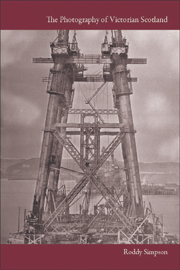Book contents
- Frontmatter
- Contents
- List of Figures
- Introduction
- 1 The Origins of Scottish Photography: Pioneering Activities in St Andrews and Edinburgh
- 2 David Octavius Hill and Robert Adamson: the ‘Partnership of Genius’ and the First Art Photography
- 3 Photography for the Few: The Activities of the Enthusiastic and Artistic Amateurs
- 4 Photography in Demand: The Work of the Increasing Number of Professional Photographers to Meet Public Demand
- 5 Scots Abroad: The Achievements of Scottish Photographers Around the World
- 6 Tourists and Travellers: Images of Scotland Produced for the Rapidly Growing Tourist Market and Photographs Taken by Visitors
- 7 Recording Social Conditions and Industrial Change: Photographs of what was Being Lost and what was Replacing it
- 8 Photography as Art: Looking at the Images and the Arguments
- 9 Populist Activity and Pictorialism: Popular Involvement with Cheap and Mass Produced Cameras and Photographers with Artistic Aspirations
- 10 Scotland's Enduring Photographic Legacy
- Bibliography
- Acknowledgements
- Index
6 - Tourists and Travellers: Images of Scotland Produced for the Rapidly Growing Tourist Market and Photographs Taken by Visitors
Published online by Cambridge University Press: 05 August 2013
- Frontmatter
- Contents
- List of Figures
- Introduction
- 1 The Origins of Scottish Photography: Pioneering Activities in St Andrews and Edinburgh
- 2 David Octavius Hill and Robert Adamson: the ‘Partnership of Genius’ and the First Art Photography
- 3 Photography for the Few: The Activities of the Enthusiastic and Artistic Amateurs
- 4 Photography in Demand: The Work of the Increasing Number of Professional Photographers to Meet Public Demand
- 5 Scots Abroad: The Achievements of Scottish Photographers Around the World
- 6 Tourists and Travellers: Images of Scotland Produced for the Rapidly Growing Tourist Market and Photographs Taken by Visitors
- 7 Recording Social Conditions and Industrial Change: Photographs of what was Being Lost and what was Replacing it
- 8 Photography as Art: Looking at the Images and the Arguments
- 9 Populist Activity and Pictorialism: Popular Involvement with Cheap and Mass Produced Cameras and Photographers with Artistic Aspirations
- 10 Scotland's Enduring Photographic Legacy
- Bibliography
- Acknowledgements
- Index
Summary
Scotland became an increasingly popular tourist destination during the nineteenth century and tourists wanted souvenirs and what better souvenir than a photographic image of the places visited? Creating photographs for the tourist market became a flourishing activity and some photographers excelled, notably George Washington Wilson of Aberdeen and James Valentine of Dundee who formed national and international business enterprises.
There were several factors involved in attracting tourists to Scotland but undoubtedly the greatest was Sir Walter Scott. His novels and poetry gave a romantic depiction of Scotland, especially its landscape, and this brought visitors flocking to the localities described. His epic poem The Lady of the Lake, with the action set around Loch Katrine and the Trossachs, put this area on the tourist map. In the Borders Melrose Abbey and Scott's home at Abbotsford became tourist Meccas, as did the village of Roslin, which featured in The Lay of the Last Minstrel.
This was also before developments that increased tourism. The railways were to make travel easier and a network of steamers made the remoter Western Highlands and Islands more accessible. In 1846 Thomas Cook arranged his first package tour to Scotland. Also, Queen Victoria's annual pilgrimage to Scotland and the building of Balmoral Castle maintained public interest and made Scotland fashionable. On a journey to Iona in 1840, Lord Cockburn, the famous judge, commented:
The number of foreign, but chiefly the English, travellers is extraordinary. They fill every conveyance and every inn, attracted by scenery, curiosity, superfluous time and wealth, and the fascination of Scott, while attracted by grouse, the mansion-houses of half of our poor devils of Highland lairds are occupied by rich and titled Southrons.
- Type
- Chapter
- Information
- The Photography of Victorian Scotland , pp. 115 - 133Publisher: Edinburgh University PressPrint publication year: 2012



